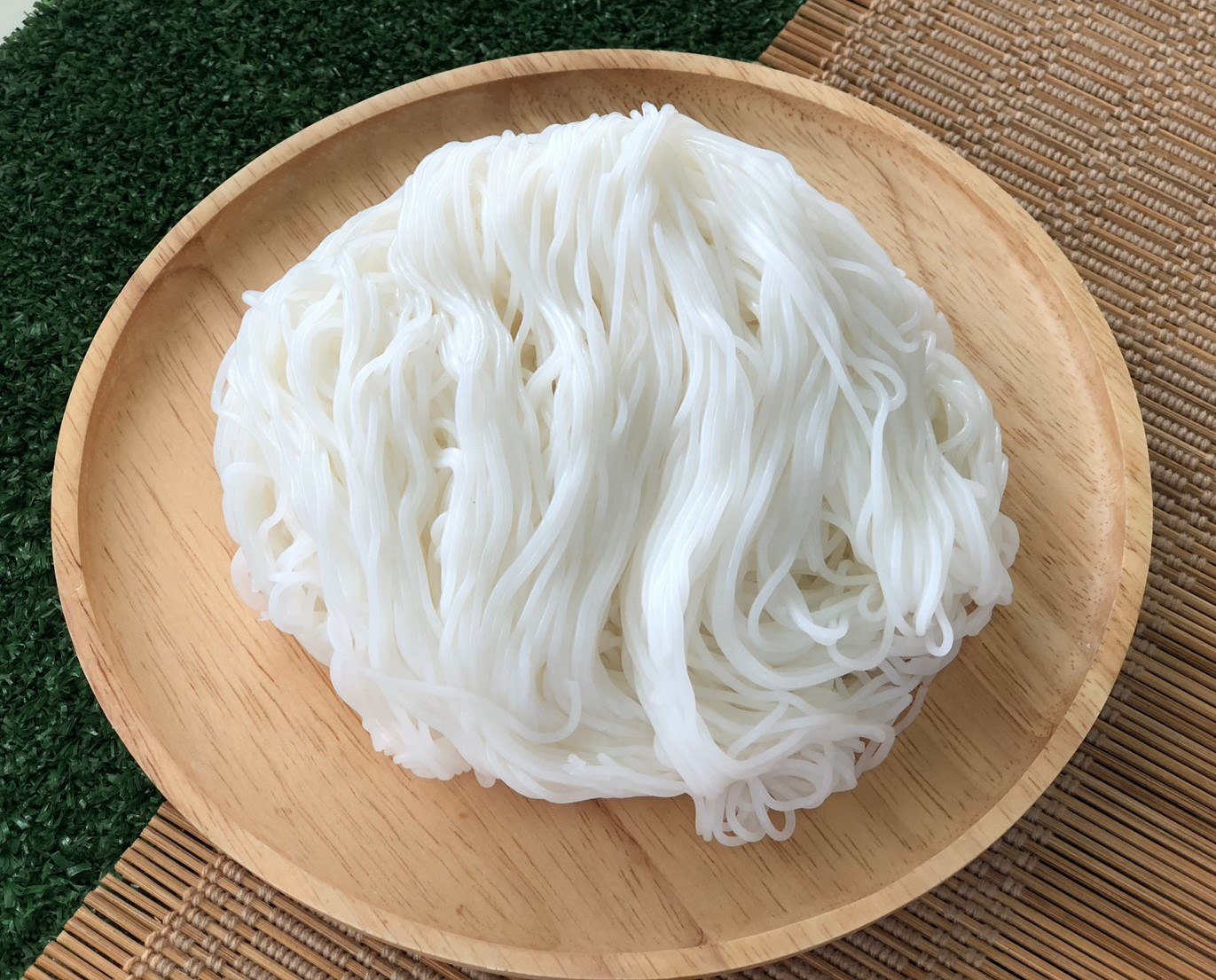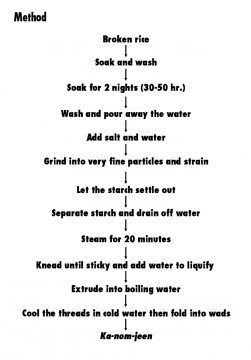Kha-nom-jeen
- Name (Thai)
- ขนมจีน
- Name (English)
- Fermented rice noodles
- Local name
- Kha-nom-jeen
- Product
- Rice
- Ingredients
- Rice: Oryza sativa (Khao-jao). Salt, water.
- Fermentation
- 30-50 hours.
- Storage life
- 2-3 days.
- Microorganisms
-
Lactococcus lactis
Reference Bacteriocinogenic lactic acid bacteria from Thai fermented foods: Potential food applications DOI 10.1016/j.fbio.2023.102385 Year 2023 Enterobacter ludwigiiReference Effect of proteolytic bacteria on texture and colour quality of khanom‐jeen, traditional Thai fermented rice noodles DOI 10.1111/lam.13210 Year 2019 Leuconostoc pseudomesenteroidesReference Characterization and antibacterial activity against Helicobacter pylori of lactic acid bacteria isolated from Thai fermented rice Noodle DOI 10.1007/s12602-018-9385-z Year 2019 Leuconostoc citreumReference Characterization and antibacterial activity against Helicobacter pylori of lactic acid bacteria isolated from Thai fermented rice Noodle DOI 10.1007/s12602-018-9385-z Year 2019 Leuconostoc lactisReference Characterization and antibacterial activity against Helicobacter pylori of lactic acid bacteria isolated from Thai fermented rice Noodle DOI 10.1007/s12602-018-9385-z Year 2019 Lactobacillus paracasei subsp. toleransReference Characterization and antibacterial activity against Helicobacter pylori of lactic acid bacteria isolated from Thai fermented rice Noodle DOI 10.1007/s12602-018-9385-z Year 2019 Lactobacillus fermentumReference Characterization and antibacterial activity against Helicobacter pylori of lactic acid bacteria isolated from Thai fermented rice Noodle DOI 10.1007/s12602-018-9385-z Year 2019 Lactobacillus plantarum subsp. plantarumReference Characterization and antibacterial activity against Helicobacter pylori of lactic acid bacteria isolated from Thai fermented rice Noodle DOI 10.1007/s12602-018-9385-z Year 2019 Lactobacillus pentosusReference Characterization and antibacterial activity against Helicobacter pylori of lactic acid bacteria isolated from Thai fermented rice Noodle DOI 10.1007/s12602-018-9385-z Year 2019 Enterococcus faeciumReference Characterization and antibacterial activity against Helicobacter pylori of lactic acid bacteria isolated from Thai fermented rice Noodle DOI 10.1007/s12602-018-9385-z Year 2019 Lactococcus lactis subsp. lactisReference Characterization and antibacterial activity against Helicobacter pylori of lactic acid bacteria isolated from Thai fermented rice Noodle DOI 10.1007/s12602-018-9385-z Year 2019 Weissella confusaReference Characterization and antibacterial activity against Helicobacter pylori of lactic acid bacteria isolated from Thai fermented rice Noodle DOI 10.1007/s12602-018-9385-z Year 2019 Acinetobacter tandoiiReference Improving the texture and color of khanomjeen, a Thai fermented rice noodle, using a modified rice fermentation method DOI 10.3136/fstr.FSTR-D-21-00146 Year 2022 Acinetobactor baumanniiReference Improving the texture and color of khanomjeen, a Thai fermented rice noodle, using a modified rice fermentation method DOI 10.3136/fstr.FSTR-D-21-00146 Year 2022 Kosakonia sacchariReference Improving the texture and color of khanomjeen, a Thai fermented rice noodle, using a modified rice fermentation method DOI 10.3136/fstr.FSTR-D-21-00146 Year 2022 Enterobacter tabaciReference Improving the texture and color of khanomjeen, a Thai fermented rice noodle, using a modified rice fermentation method DOI 10.3136/fstr.FSTR-D-21-00146 Year 2022 Cronobacter malonaticusReference Improving the texture and color of khanomjeen, a Thai fermented rice noodle, using a modified rice fermentation method DOI 10.3136/fstr.FSTR-D-21-00146 Year 2022 Komagatataeibacter medellinensisReference Improving the texture and color of khanomjeen, a Thai fermented rice noodle, using a modified rice fermentation method DOI 10.3136/fstr.FSTR-D-21-00146 Year 2022 Gluconacetobacter liquefaciensReference Improving the texture and color of khanomjeen, a Thai fermented rice noodle, using a modified rice fermentation method DOI 10.3136/fstr.FSTR-D-21-00146 Year 2022 Lactotoccus lactisReference Improving the texture and color of khanomjeen, a Thai fermented rice noodle, using a modified rice fermentation method DOI 10.3136/fstr.FSTR-D-21-00146 Year 2022 Weissella confusaReference Improving the texture and color of khanomjeen, a Thai fermented rice noodle, using a modified rice fermentation method DOI 10.3136/fstr.FSTR-D-21-00146 Year 2022 Lactobacillus ultunensisReference Improving the texture and color of khanomjeen, a Thai fermented rice noodle, using a modified rice fermentation method DOI 10.3136/fstr.FSTR-D-21-00146 Year 2022 Lactobacillus plantarumReference Improving the texture and color of khanomjeen, a Thai fermented rice noodle, using a modified rice fermentation method DOI 10.3136/fstr.FSTR-D-21-00146 Year 2022 lactobacilllus fermentumReference Improving the texture and color of khanomjeen, a Thai fermented rice noodle, using a modified rice fermentation method DOI 10.3136/fstr.FSTR-D-21-00146 Year 2022 Enterococcus faecalisReference Improving the texture and color of khanomjeen, a Thai fermented rice noodle, using a modified rice fermentation method DOI 10.3136/fstr.FSTR-D-21-00146 Year 2022 Enterococcus camelliaeReference Improving the texture and color of khanomjeen, a Thai fermented rice noodle, using a modified rice fermentation method DOI 10.3136/fstr.FSTR-D-21-00146 Year 2022 Staphylococcus gallinarumReference Improving the texture and color of khanomjeen, a Thai fermented rice noodle, using a modified rice fermentation method DOI 10.3136/fstr.FSTR-D-21-00146 Year 2022 Kurthis gibsoniiReference Improving the texture and color of khanomjeen, a Thai fermented rice noodle, using a modified rice fermentation method DOI 10.3136/fstr.FSTR-D-21-00146 Year 2022 Bacillus wiedmanniiReference Improving the texture and color of khanomjeen, a Thai fermented rice noodle, using a modified rice fermentation method DOI 10.3136/fstr.FSTR-D-21-00146 Year 2022 Loriellopsis cavernicolaReference Improving the texture and color of khanomjeen, a Thai fermented rice noodle, using a modified rice fermentation method DOI 10.3136/fstr.FSTR-D-21-00146 Year 2022 Chyseobacterium oranimenseReference Improving the texture and color of khanomjeen, a Thai fermented rice noodle, using a modified rice fermentation method DOI 10.3136/fstr.FSTR-D-21-00146 Year 2022 - Properties
- Solid thin, round noodles, sold fresh in the form of wads that look like birds' nests.
- Method
- 1. Wash and soak the rice in water overnight, and drain in a straining container to proceed the solid-state rice fermentation for over night, followed by washing in water and drain in the container to repeat the solid-state rice fermentation one or two more times. After the soli-state fermentation, the rice is wet-milled and precipitated in 2% salt water for two to three days to conduct the submerged rice flour fermentation. The supernatant is replaced every day with fresh 2% salt water. The fermened rice flour is then strained through the thick cloth. 2. The strained fermented rice flour is poured into into a cloth bag and tightly closed, followed by Weighing the bag down overnight to drain off the water 3. Steam the fermented rice flour in the the bag. Add water to the stramed fermented rice flour and knead until it forms a smooth paste. 4. Extrude the fermented rice flour paste into boiling water to form noodles, and then transfer the finished fermented rice noodles into cold water for washing. The washed fermented rice noodles are bundled and placed in a plastic draining basket.
- Production
- In small scale industry and home industry.
- Consumption
- Eat with a spicy sauce. Kha-mom-jeen should be eaten within a few days of being made.


